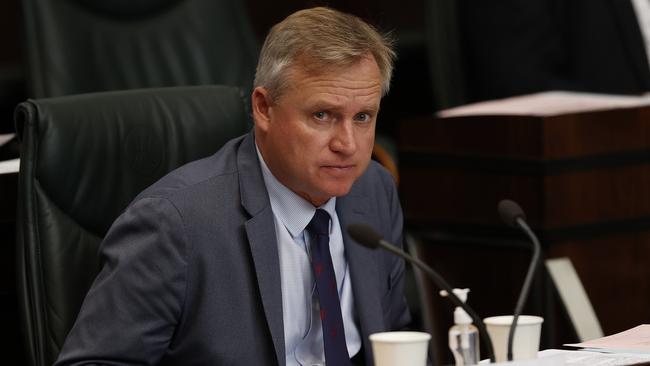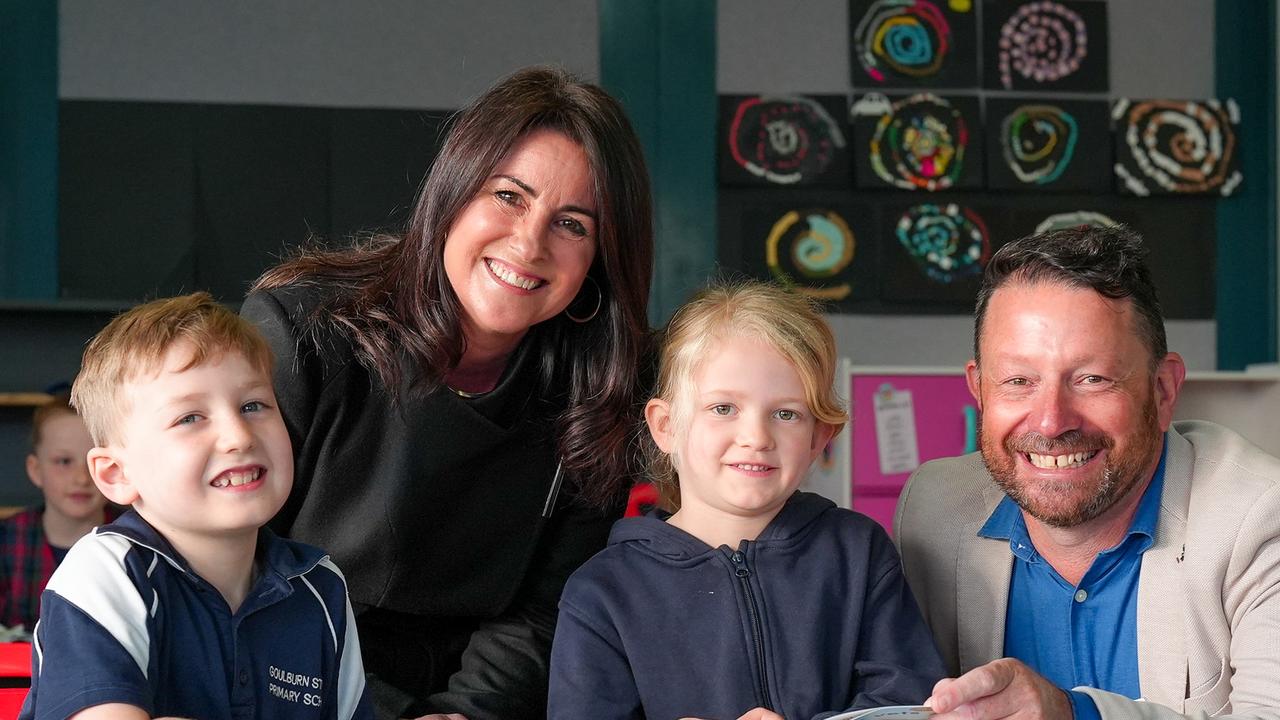Feeder schools for Tasmanian high schools to be reviewed
The state government has revealed when it will review school catchment areas, as debate swirls around plans to shift schools from single-sex to co-ed.

Education
Don't miss out on the headlines from Education. Followed categories will be added to My News.
TASMANIA’S school zones will be reviewed after 2022, as new figures reveal more than three-quarters of Hobart’s secondary students travel outside their area for school.
Enrolment data show that of the 898 high school students living within the Hobart local government area, 677, or 75 per cent, attend co-ed schools outside the LGA.
Just 221 students living in Hobart attend their local high schools, Ogilvie and New Town, which are currently single-sex but will transition to co-ed in 2022.
The figures, revealed by Education Minister Jeremy Rockliff in response to a parliamentary question on notice from Upper House MP Rob Valentine, show the vast majority of Hobart secondary students — 646 — attend Taroona High School.
Rose Bay, Montrose, Kingston, Cosgrove and Clarence high schools each receive a handful of students from the Hobart LGA.
BEST UNIS: WHICH UNIS WILL GET TASSIE STUDENTS A JOB?

Mr Rockliff said changing the number of Hobart primary schools that feed into Taroona High was not on the cards – yet.
“At this stage there is no intention to make changes to the feeder and access school arrangements,” Mr Rockliff said.
“This will be reviewed once a model has been implemented and has been operating for a period of time so that we can get a sense of the distribution of students across Hobart.”
NAPLAN SPECIAL REPORTS:
Top Tasmanian performers revealed
50 most improved Tasmanian schools across five years of NAPLAN results
Best performing Tasmanian high schools
Best performing Tasmanian primary schools
As indicated in a consultants’ report on demand for co-ed schooling in Hobart, which was released by Mr Rockliff during the week, there were a range of reasons families chose Taroona High, including reputation, facilities and teacher quality.
CO-ED SCHOOL ‘TICKS ALL THE BOXES’
For West Hobart teenager Sam Eccleston, having to catch the bus to Taroona each day is a small price to pay for attending a school he loves.
The 15-year-old, who is Taroona’s year nine student council president, is one of hundreds of secondary students living in Hobart who catch the bus to Taroona in nearby Kingborough.
His other option for a public high school was New Town, which is currently boys-only, but will switch to co-ed along with nearby Ogilvie High for girls in 2022.

Mr Eccleston said Taroona “ticks all the boxes” of co-education: a strong school community, quality teachers and excellent facilities – not to mention the stunning waterfront location.
“Having to take the bus to Taroona is a small price to pay, especially because of the location, it’s a really stunning spot,” he said.
MORE EDUCATION SPECIAL REPORTS:
Expensive or cheap? Search and compare all Tasmanian public school charges
Tasmania’ top 100 achieving students for 2019
50 Tasmanian schools with best teacher resources
50 Tasmanian schools with worst teacher v student ratios
How much each Tasmanian school makes from your fees and other charges
INVESTMENT NEEDED TO BOOST SCHOOLS
One Tasmanian political powerbroker, with a strong vested interest in Ogilvie High School, said the figures showed the importance of investing to make Ogilvie and New Town “top flight” schools to rival Taroona.
“That was the intention when my great uncle started Ogilvie back in the ’30s,” said Labor MP-turned-independent Madeleine Ogilvie, whose great uncle was former premier A.G. Ogilvie.
“My rough figure is a $20 million investment. We are talking about a major step change in how those schools will operate and it will require substantial investment. Plus I also want to see more investment in more teachers and more classes, particularly specialist classes such as singing and music and the performing arts.”

Although the government has announced it will make both schools co-ed in 2022, with the model to be worked out over the next 12 months, Ms Ogilvie is holding out hope that Tasmania will not lose its only state-run girls school.
“Let’s look carefully at all the possible models. For example, has anyone considered retaining Ogilvie as a single-sex girls school and making New Town co-ed?” Ms Ogilvie said.
END OF THE LINE FOR SINGLE-SEX SCHOOLS
However, as debate continues over the future of single-sex education in Tasmania, one education expert predicts girls’ and boys’ schools could be a thing of the past in little more than a decade.
Author and educator Judith Gill, an adjunct associate professor at the University of South Australia, has helped multiple schools in SA make the shift from single-sex to co-ed.
“I really think there will be very few single-sex schools by 2050, perhaps even by 2030,” Prof Gill said.
“The demand (for co-ed) is steaming ahead very quietly and steadily.”
Of the 1031 people surveyed as part of a consultants’ study on the issue of high school offerings in Hobart, 88 per cent preferred a co-ed model and Prof Gill said that reflected a nationwide trend.

Girls’ school advocates in particular often argue that research shows female students fare better and are more likely to do STEM subjects if they attend single-sex schools, but Prof Gill said that was a myth not backed up by evidence.
Tasmanian education expert Natalie Brown from the Peter Underwood Centre agreed, saying school cultures and structures and parent attitudes were far more important than whether a school was single-sex or co-ed.
“There’s a lot of research out there but it’s very inconclusive. It’s very hard to separate the effect of being in a single sex school from other attributes of the young people or their families and socio-economic context,” Professor Brown said.

The head of Tasmania’s best-known boys’ schools, Hutchins, Rob McEwan, said single-sex was not a “magic bullet”.
“The fact that you’re a school with all girls or all boys does not make it a good school,” Dr McEwan said.
“We’ve seen far too many examples of single-sex schools behaving badly in other states. It’s the culture within the school and the values and messaging. The sort of behaviours that you reward and praise.”
Having worked at three private schools interstate that converted from single-sex to co-ed, Dr McEwan agreed with Prof Gill that such decisions were always made on economic, rather than philosophical, grounds.
“All of them became co-ed for economic reasons and Hutchins put its toe in the water back in 1971 for exactly the same reasons,” Dr McEwan said.
Dr McEwan said there was currently “no need” for Hutchins to consider going co-ed because enrolments were strong.
“It’s quite a progressive and contemporary school, in that the gender stereotypes that used to apply to single-sex schools don’t apply. We have 120 boys involved in dance across pre-kinder to year 12 and I have never seen as many boys singing as I have at the Hutchins School,” he said.

The principals of two Hobart girls’ schools were more devoted to the single-sex philosophy.
“Girls’ schools design and tailor every aspect of school life for girls, and inherent in that design is a freedom from stereotypes and a removal of barriers,” said Fahan principal Penny Curran-Peters.
She said the school encouraged “healthy risk-taking, pursuing improvement, embracing failure, speaking up with confidence and courage”.
Her comments were echoed by St Michael’s Collegiate principal Adam Forsyth.
“Specific outcomes I see at Collegiate are happy, confident girls and young women who are not restrained by gender stereotypes in any way and who take on all manner of challenges and leadership roles with gusto,” Dr Forsyth said.


